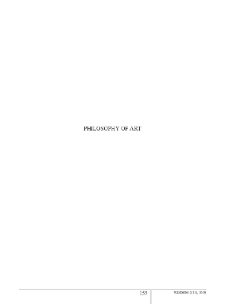Object
Title: The Vision And The Enigma: Nietzsche’s Aura In De Chirico’s Art
Journal or Publication Title:
Date of publication:
Volume:
Number:
ISSN:
Corporate Creators:
Խ․ Աբովյանի անվան հայկական պետական մանկավարժական համալսարան
Coverage:
Abstract:
Giorgio De Chirico definitely stands out as a peculiar character of the Italian Novecento and his art ties directly with Nietzsche‟s philosophy whose eternal questions paved the way to his “immanent metaphysics” which is typified and pervaded by ever-present melancholia brought about by a heightened awareness of the death of God. Grappling with “the world seen for the first time” De Chirico‟s narrative does not depict reality rather its ghost, the latter is seen by dint of revelations and hallucinations. This paper sheds light onto some significant kinships between the two characters as not only philosophical concerns are vital but illness too. The philosopher suffered since his very childhood from severe migraine and then from a psychiatric illness with depression while the painter unknowingly suffered from migraine aura. This ailment, affecting the fragile border amid perceived reality and hallucinated reality, turned out to be a remarkable source of inspiration which boosted the visions and the enigmas the artist was entwined with. Overall, Nietzsche ushered in a picture of the world that De Chirico has wholeheartedly shared, however, in the light of his disorder, the empathy went even further, and this is the noteworthy aspect this paper aims at underscoring.
Place of publishing:
Երևան
Publisher:
Format:
Identifier:
oai:arar.sci.am:370511
Language:
Object collections:
Last modified:
Oct 8, 2025
In our library since:
Feb 21, 2024
Number of object content hits:
55
All available object's versions:
https://arar.sci.am/publication/400330
Show description in RDF format:
Show description in OAI-PMH format:
-
Իմաստություն=Wisdom=Мудрость
-
Իմաստություն, 2013, N 1
-
Իմաստություն, 2014, N 1 (2)
-
Իմաստություն, 2014, N 2 (3)
-
Իմաստություն, 2015, N 1 (4)
-
Wisdom, 2015, N 2 (5)
-
Wisdom, 2016, N 1 (6)
-
Wisdom, 2016, N 2 (7)
-
Wisdom, 2017, N 1 (8)
-
Wisdom, 2017, N 2 (9)
-
Wisdom, 2018, N 1 (10)
-
Wisdom, 2018, N 2 (11)
-
Wisdom, 2019, N 1 (12)
-
Wisdom, 2019, N 2 (13)
- Editorial board
- Content
- Editor`s Foreword
- Verbal And Non-Verbal Characteristics Of Approval Speech Act
- Linguistic Structural Conceptual Framework of Literary Non-Fiction
- The Link Between Necessity And Randomness In Scientific Discovery
- A Comparative Study of Political Process: Theoretical and Methodological Issues
- Model Of The Evolution Of Social Development In The Philosophy Of Global Constitutionalism
- Multifactorial Model Of Attitudes Towards Appearance: Empirical Investigations
- Typical Expression Of Cognitive Dissonance And Consonance In The Course Of Argumentation Among Primary-School Children Playing Chess
- Politics as Personal Freedom: An Analysis of Max Weber’s Speech “Politics as a Vocation”
- Change And Variability Of Phenomena In Complex Social Systems
- An Impact of Social Networks Cyber Ethics on the Modern Identity Formation
- Analysis Of Generations For The Youth Research Methodology
- Science And Education In The Conditions Of Formation Of The Global World
- Perception Of The Spiritual Symbol In Armenian Medieval Philosophy And Theology
- Cultural Globalisation, Consumer Society And Fashion Industry In Russia: New Socio-Historical Trends
- The Vision And The Enigma: Nietzsche’s Aura In De Chirico’s Art
- Barry Stroud (1935-2019)
- Igor Zaslavsky (1932-2019)
- Notes to Contributors
- Authors
-
Wisdom, 2020, N 1 (14)
-
Wisdom, 2020, N 2 (15)
-
Wisdom, 2020, N 3 (16)
-
Wisdom, 2021, N 1 (17)
-
Wisdom, 2021, N 1 (1) Special issue
-
Wisdom, 2021, N 2 (18)
-
Wisdom, 2021, N 3 (19)
-
Wisdom, 2021, N 4 (20)
-
Wisdom, 2022, N 1 (21)
-
Wisdom, 2022, N 1 (2) Special issue
-
Wisdom, 2022, N 2 (22)
-
Wisdom, 2022, N 2 (3) Special issue
-
Wisdom, 2022, N 3 (23)
-
Wisdom, 2022, N 3 (4) Special issue
-
Wisdom, 2022, N 4 (24)
-
Wisdom, 2023, N 1 (25)
-
Wisdom, 2023, N 2 (26)
-
Wisdom, 2023, N 3 (27)
-
Wisdom, 2023, N 4 (28)
-
Wisdom, 2024, N 1 (29)
-
Wisdom, 2024, N 2 (30)
-
Իմաստություն, 2013, N 1
| Edition name | Date |
|---|---|
| Giuliodori, Lucio, The Vision And The Enigma: Nietzsche’s Aura In De Chirico’s Art | Oct 8, 2025 |





